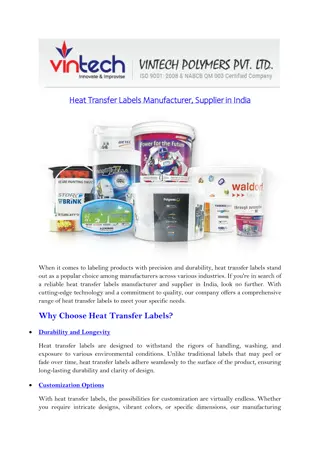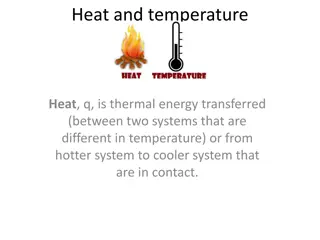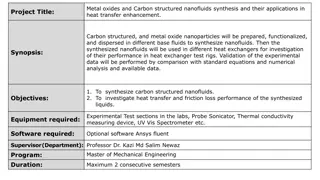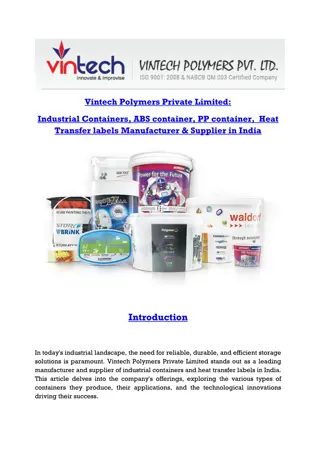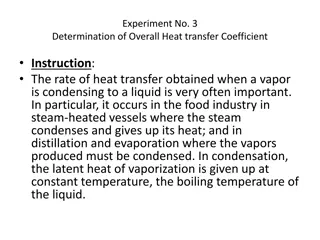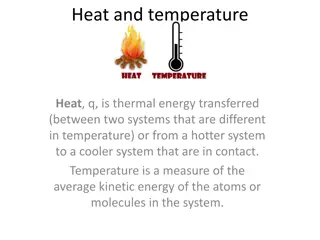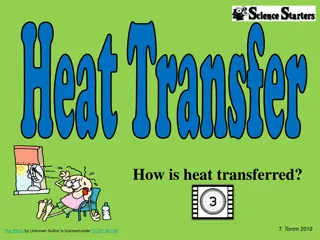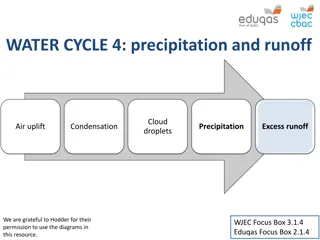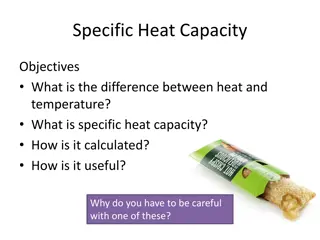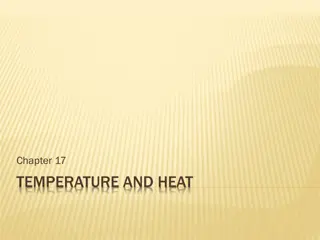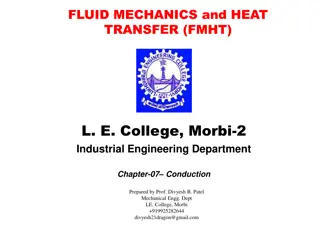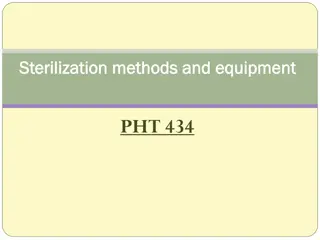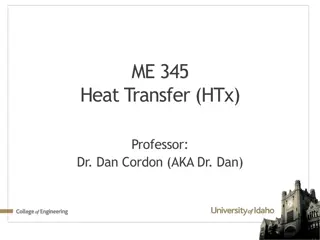Heat Transfer in Condensation Processes: Film and Dropwise Mechanisms
Film condensation inside horizontal tubes for low vapor velocity is explored, highlighting the importance of the condensation number and heat transfer coefficients. Dropwise condensation, characterized by droplets on the surface, is also discussed for its effectiveness in heat transfer. The condensation number is introduced to express heat transfer coefficients in terms of Reynolds number. Examples involving saturated steam condensing on vertical plates demonstrate the application of these concepts in real-world scenarios.
Download Presentation

Please find below an Image/Link to download the presentation.
The content on the website is provided AS IS for your information and personal use only. It may not be sold, licensed, or shared on other websites without obtaining consent from the author.If you encounter any issues during the download, it is possible that the publisher has removed the file from their server.
You are allowed to download the files provided on this website for personal or commercial use, subject to the condition that they are used lawfully. All files are the property of their respective owners.
The content on the website is provided AS IS for your information and personal use only. It may not be sold, licensed, or shared on other websites without obtaining consent from the author.
E N D
Presentation Transcript
FILM CONDENSATION INSIDE HORIZONTAL TUBES For low vapor velocity ??? ????? ????3 ?? ?????? ??? 1//4 = 0.555 ????? ?? For ???????= < 3500 1
DROPWISE CONDENSATION Dropwise condensation, characterized by countless droplets of varying diameters on the condensing surface instead of a continuous liquid film, is one of the most effective mechanisms of heat transfer, and extremely large heat transfer coefficients can be achieved with this mechanism. ????????= 51104 + 204???? 22?? < ????< 100?? ????????= 255510 for ????> 100?? 2
The Condensation Number Because the film Reynolds number is so important in determining condensation behavior, it is convenient t o express the heat-transfer coefficient directly in terms of Re. We include the effect of inclination and write the heat- transfer equations in the form 1/4 3 ???? ??????? ???? ??? ?? ?? = ? where the constant is evaluated for a plate or cylindrical geometry. From the equation: ? = ? ?? ?? = ? ?? ?? ?? = ? We now define a new dimensionless group, the condensation number Co, as 1/3 (19) (18) ? ?? ?2 ?? = ?3???? ??? 3
For a vertical plate A/PL = 1.0, and we obtain, using the constant from Equation (1) 1/3 for ???< 1800 ?? = 1.47 ??? For a horizontal cylinder A/PL = and 1/3 for ???< 1800 ?? = 1.514 ??? When turbulence is encountered in the film, an empirical correlation by Kirkbride may be used: 0.4 for ???> 1800 ?? = 0.0077 ??? 4
Example 1- Saturated steam at 1atm condenses on a 3m-high and 5m-wide vertical plate that is maintained at 90 C by circulating cooling water through the other side. Determine (a) the rate of heat transfer by condensation to the plate, and (b) the rate at which the condensate drips off the plate at the bottom. Solution: L=3m and w=5m for vertical plate Tw=90oC, Tsat=100oC at 1atm. ???? ?? 2 2 The properties: f=961.5kg/m3, v=0.5045kg.m3, hfg=2270kJ/kg, kf=0.677W/m.K, Cpf=4212J/kg.K, f=0.297x10-3kg/m.sec, Prf=1.85 =100+90 = 95?? ??= 5
Requirements: a) The rate of heat transfer, b) the rate at which the condensate drips off the plate. Analysis: at beginning we find modified hfg ?? = ??+ 0.68??????? ?? ?? = 2270 103+ 0.68 4212 100 90 = 2312.13 103?/?? Assuming wavy laminar flow then ?? = ?????,???? 0.82 1/3 2 ??? ?? 3.70??????? ?? ?? ?? = 4.81 + 2 6
1/30.82 9.81 961.52 0.293 10 3 2 3.70 3 0.677 100 90 0.297 10 3 ?? = ?????,????= 4.81 + = 2312.13 103 It between 30 and 1800 then 1110.73 1/3 2 ??? ?? ???? = 2 1.08??1.22 5.2 1110.73 0.677 1.08 1110.731.22 5.2 ? = ? ???? ?? = 6340.8 3 5 100 90 = 951119? = 915.12?? 1/3 9.81 961.52 0.293 10 3 2 = 6340.8?/m2K. = ? ?? 915.12 2312.13= 0.411??/??? Mass of condensate is ? = = To calculate the condensation Number Co ?? = 1.47 ??? ?? = 1.47 1110.73 1/3= 0.142 1/3 for ???< 1800 7
Example 2. Saturated steam at 30C condenses on the outside of a 4cm-outer diameter, 2m-long temperature of the tube is maintained at 20 C by the cooling water. Determine (a) the rate of heat transfer from the steam to the cooling water, (b) the rate of condensation of steam, and (c) the approximate thickness of the liquid film at the bottom of the tube. Solution: Saturated steam at Tsat=30o condenses on tube(its outside) D=4cm L=2m Tw=20oC. vertical tube. The 8
Properties: properties of steam at Tf=25oC are f=997kg/m3 hfg=2442kJ/kg, Cpf=4180J/kg.K, kf=0.607W/m.K, f=0.891x10-3, Prf=6.14. Requirements; a) rate of heat transfer, b) rate of steam condensation, c) the thickness of liquid film at bottom of the tube Analysis: at the beginning, we shall determine the modified hfg* ?? = ??+ 0.68??????? ?? ?? = 2440 103+ 0.68 4180 30 20 = 2,468.42 103?/?? 9
Assume, wavy-laminar flow then 1/30.82 2 ??? ?? 3.70??????? ?? ?? ?? ?? = ?????,????= 4.81 + 2 ?? = ?????,????= 4.81 1/30.82 9.81 9972 0.891 10 3 2 3.70 2 0.697 30 20 0.891 10 3 = 175.56 Which is between 30 and 1800, and thus our assumption of wavy laminar flow is verified. Then the condensation heat transfer coefficient is determined to be 1/3 + 2,468.42 103 2 ??? ?? ???? = 2 1.08??1.22 5.2 175.56 0.697 1.08 175.561.22 5.2 /m2K 1/3 9.81 9972 0.891 10 3 2 = = 4,819.2? 10
? = ? ???? ?? = ??? 4819.2 10 = ? 0.04 2 4819.2 = 12,112? = 12.112?? 30 ? ?? 12.112 2,468.42 Mass of condensate is ? = = =0.0049?? ??? The thickness of the film at the bottom is = 17.66??/hr 4?? 3 = 4 0.607 3 4819.2= 0.126?? ??= 11
3- The tube bank of a steam condenser consists of a square array of 400 tubes, each of diameter D= 2r1=6mm. If horizontal, tubes are exposed to saturated steam at a temperature of 55oC and the tube surface is maintained at Tw=25oC, what is the rate at which steam is condensed per unit length of the tube bank? Solution: tube bank of steam condenser consists of a square array of 400tubes, D=6mm. Tsat=55oC, Tw=25oC Properties: the properties of saturated water at Tf=40oC 12
f=992.1kg/m3, v=0.0512kg/m3, Cpf=4179J/kg.K, hfg=2407kJ/kg, kf=0.631W/m.K f=0.653x10- 3kg/m.sec, Prf=1.03 Requirements: rate at which steam is condensed per unit length. Analysis: ?? = ??+ 0.68??????? ?? = 2407 + 0.68 4.179 55 25 = 2492.25?? /?? 1/4 ?? 3 ????? ?? ?? ?????? ??? = 0.729 = 0.729 9.81 992.1 992.1 0.0512 2499 1030.6313 0.653 10 355 25 0.006 = 8288.4?/m2.K 1/4 13
4=8288.4 ?= 201/4= 3919.34?/m2K 1 ? ? = ? ???? ????? ?? = 20 20? 0.006 3919.34 55 25 = 886.53??/m Mass condensates per unit length is ? ?? 886.53 2492.25 ? = = = 0.356??/sec=21.34kg/min 14
4- Saturated steam at 120oC condenses inside a horizontal, 75mm-diameter pipe whose surface is maintained at 100oC. Assuming low vapor velocities and film condensation, estimate the heat transfer coefficient and the condensation rate per unit length of the pipe. Solution: Tsat=120oC, Tw=100oC, Di=0.075m Properties: for water at Tf=110oC, f=950.6kg/m3, v=0.8263kg/m3, hfg=2230kJ/kg, Cpf=4.229kJ/kg.K, kf=0.682W/m.K, f=0.855x10-3kg/m.sec 15
Requirement: mass of steam condensate per unit length of the tube Analysis: ?? = ??+ 0.68??????? ?? = 2230 103 + 0.68 4229 120 100 = 2287.5 103?/?? 1/4 ????? ????3 ?? ?????? ??? ???= 0.555 1/4 9.81 950.6 950.6 0.8263 0.6823 2287.5 103 0.855x10 3120 100 0.075 ???= 0.555 = 4669.6?/?2.K ? = ??? ?????? ?? = ? 0.075 1 4669.6 100 = 22005? = 22?? ? ?? 120 22005 2287.5 103= 0.0096??/???=34.56kg/hr ? = = 16


